Day 2 of a long weekend of tours today. Despite the fact that we were planning to do the Holkham area today, we had a request from the group to make a detour at the start, so we headed back to Choseley.
It didn’t take long to find the Dotterel, a small trip of three of them running around in a bare field. They were a bit distant at first but we got them in the scope and got a good look at them, particularly as they came a little closer. While we were standing there, we could also hear the sound of jangling keys from the hedge in front of us – a Corn Bunting singing.
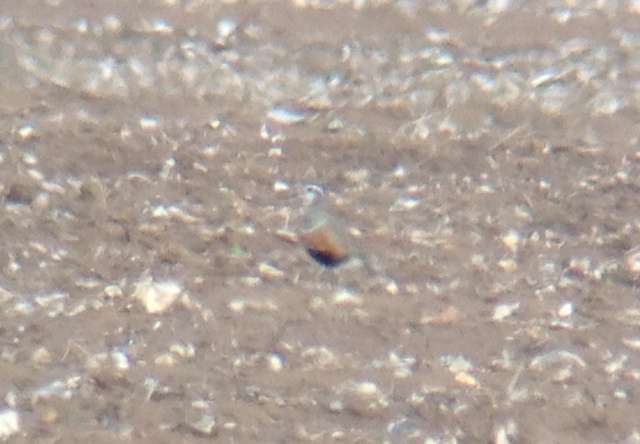 Dotterel – three were in a field at Choseley today
Dotterel – three were in a field at Choseley today
Then it was time to return to the planned programme, and we drove back to Burnham Overy. On the walk out to the seawall, we paused to admire a Speckled Wood butterfly on the path. A Lesser Whitethroat made its way inland along the hedgerow and a second sang from deep in the bushes further along. A pair of Grey Partridge skulked in the grass in one of the fields.
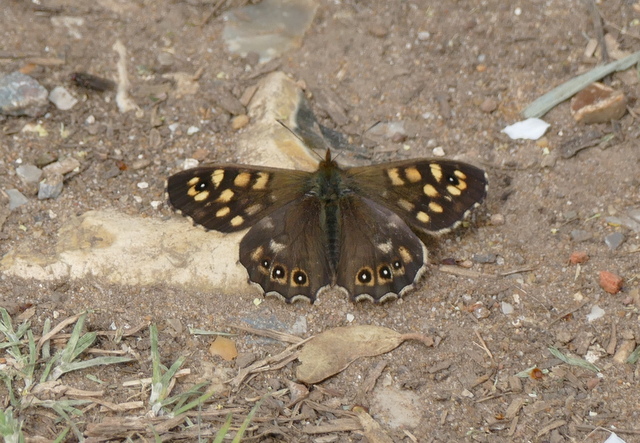 Speckled Wood – basking on the path out to Burnham Overy Dunes
Speckled Wood – basking on the path out to Burnham Overy Dunes
As we walked across the grazing marshes, we could hear the distinctive laughing sound of a couple of Whimbrel. We picked them up, flying towards us, and they circled round calling before dropping down into the fields out of view. Shortly afterwards, we picked up another flock of 7 Whimbrel further out circling over the dunes.
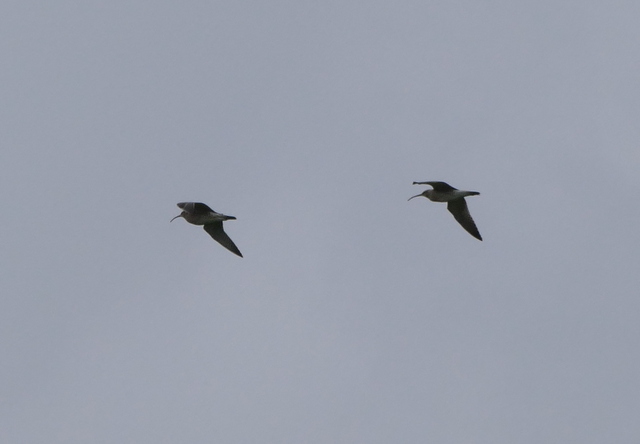 Whimbrel – these two circled over us, calling
Whimbrel – these two circled over us, calling
There were several Little Egrets out on the grazing marshes or flying overhead with their necks tucked in. Then another large white bird flew over from the direction of the harbour with its neck held outstretched – a Spoonbill. We watched it fly over the grazing marsh and drop down towards the trees. From up on the seawall, whilst scanning the reedbed, we could hear a distinctive, low foghorn-like sound. A Bittern was booming from the reeds. A nice surprise.
Scanning over the saltmarsh the other side, towards the harbour, we could see a little group of waders. They were mostly Black-tailed Godwits, many in smart orange summer plumage, plus a few Redshanks and, further out, lots of Oystercatcher. A little further along, we picked up a cracking Grey Plover coming into summer plumage – we could see where it gets its North American name, Black-bellied Plover (we had a Canadian member in the group!).
Over the harbour channel, 4 or 5 Little Terns were flying back and forth and hovering. In amongst them was a single Common Tern as well. Further out in the harbour, towards the dunes, a male Red-breasted Merganser was on the water.
A couple of Yellow Wagtails flew overhead, calling, as we walked out along the seawall. But a closer bird, a smart male, flew low past us out in the dunes. There was also a steady trickle of Swallows passing west. However, the real highlight of the walk out towards Gun Hill was the Wheatears. One male in particular performed for the assembled crowd, flying off ahead of us initially, before settling down and letting us approach more closely. He was a big, long-legged bird, with a rich orange throat and upper breast and paler orangey wash to the rest of the underparts, so different from the birds with much whiter underparts we see earlier in spring. There was a good reason for his distinctive appearance – at this time of year the birds are increasingly Greenland Wheatears, of the race leucorhoa, on their way much further north (and west).
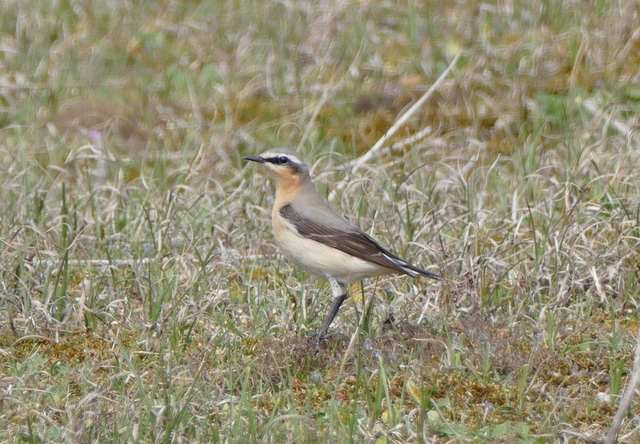 Wheatear – a richly-coloured bird of the Greenland race
Wheatear – a richly-coloured bird of the Greenland race
We walked out to the end of the dunes at Gun Hill but, apart from lots of Linnets, there were no other birds of note. A sunny weekend in April, there was just too much disturbance by this stage of the day – loads of dogwalkers and people out for a pre-lunch stroll. The birds had clearly all made for cover.
It was at this stage that we learned of a White-tailed Eagle which had just been seen over Cley and was heading west. If it kept coming this way, surely it would pass by us. We continued to walk back through the dunes, looking for migrants, but after the eagle was reported flying west past the end of Blakeney Point, still heading in our direction, we knew we were in with a chance. We headed for a high point in the dunes, briefly distracted on our way there by a Cuckoo which flew right round us before going back the way it had come.
We had an anxious wait up on the top of the dunes, carefully scanning the sky all around us. Finally, after about 20 minutes, we picked up the White-tailed Eagle flying west over the sea. It was distant at first, and away to the east, but gradually made its way until it was directly offshore in front of us. It was an adult – we could see its paler head as it caught the light and, just when it circled, its white tail. We noted its enormous size and long, broad, parallel-edged wings – it is not affectionately known as the flying barn door for nothing!
The weather had just clouded over and the White-tailed Eagle appeared to be losing height over the sea. Then it turned and started to make its way slowly inshore. For a few moments we thought it might come straight towards us, before it veered back east. It circled off Holkham beach for a while, before coming inland over the pines where it found a thermal and started to gain height again. A Marsh Harrier had clearly seen it as well and circled up quickly beneath it, eventually catching it up. It looked tiny by comparison! It had a couple of swoops at the White-tailed Eagle before we finally lost sight of them high over Holkham. What a stunning sight!
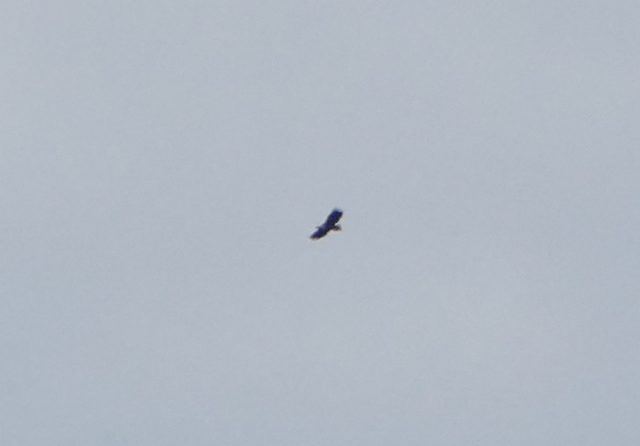 White-tailed Eagle – circling off Burnham Overy
White-tailed Eagle – circling off Burnham Overy
After our vigil with the White-tailed Eagle, it was getting on to lunch time already, and we hadn’t really managed to explore the dunes properly. We had a quick look in the dunes east of the end of the boardwalk, seeing lots more Wheatears and a cracking male Whinchat with them. Another Cuckoo flew past us. Then we really had to head back to get something to eat.
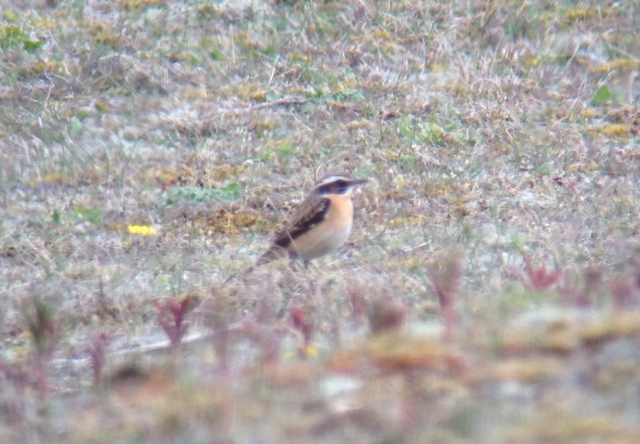 Whinchat – a lovely male in the dunes
Whinchat – a lovely male in the dunes
As we walked back along the path from the seawall, a large group of at least 11 Yellow Wagtails flew over, calling. There are a few cows out on the grazing marshes, but unfortunately they had chosen this moment to walk out to the other side of the fields. The wagtails dropped down into the grass with them, but out of view.
After a late lunch, we drove round to Holkham. The wind had picked up and, even though it was still bright and sunny, there was little activity on the edge of the pines. We did, however, manage to pick up a Reed Warbler singing out on the edge of the grazing marsh (later, on our way back, there were two singing together). There were also several Willow Warblers singing in the sallows by the track.
There wasn’t much activity from the Joe Jordan hide. A few Marsh Harriers were flying back and forth. Out on the grazing marshes we could see a little gaggle of Pink-footed Geese, a few lingering birds (most of the over-wintering geese left already in February). A Peregrine circled up over the trees. But there was no sign of any Spoonbills around the heronry. A little further on and we could see why – three birds were asleep in the trees, tucked down out of the wind, but still in the sun. A perfect spot to do what Spoonbills do best – sleep!
We continued up into the dunes and, as we arrived, we just managed to spot two Ring Ouzels perched up in a bush. We got them in the scope, two smart males, and everyone had a quick look before they disappeared out of sight. Not surprisingly, given all the disturbance in the dunes today, they were tucked down behind the fence in the nature reserve. A quick walk round the public part of the dunes just beyond the pines did not produce any more migrants. And then it was time to call it a day.
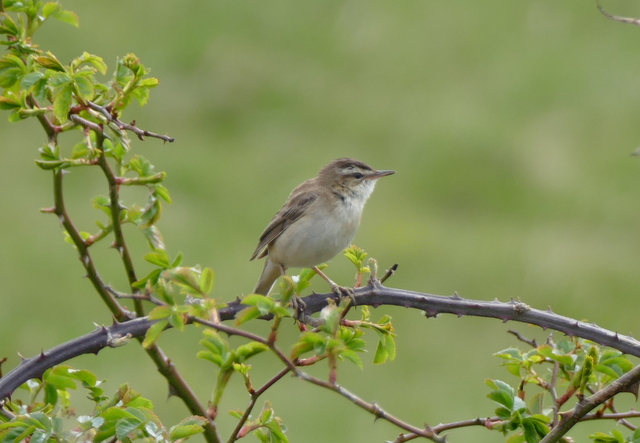 Sedge Warbler – lots singing today, but still few Reed Warblers
Sedge Warbler – lots singing today, but still few Reed Warblers
















